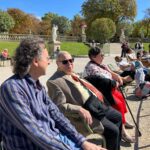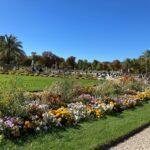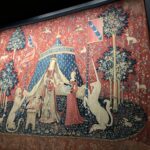 On our seventh day in Paris, Richard’s cousins (and we’re talking distant, like about 4th or 5th cousins) had come to see us. They live in a village in eastern France about an hour’s drive from Strasbourg, the farthest east French city, right near the German border. Bernard and Eliane took the train, which is about a three or four hour trip, and stayed at Eliane’s brother’s home in Paris.
On our seventh day in Paris, Richard’s cousins (and we’re talking distant, like about 4th or 5th cousins) had come to see us. They live in a village in eastern France about an hour’s drive from Strasbourg, the farthest east French city, right near the German border. Bernard and Eliane took the train, which is about a three or four hour trip, and stayed at Eliane’s brother’s home in Paris.
They came to our hotel and after some hugs and kisses, we set of on a half-mile walk toward Luxembourg Garden (Le Jardin du Luxembourg). We stopped at a café for lunch on the way, and none of us were particularly impressed with the meal or the service, but it sustained us for the day ahead. Bernard speaks a little bit of English, and I speak a little bit of French, so we were able to communicate, or at least we thought we knew what each other were saying. I got the sense that Eliane understood some English but didn’t speak it, perhaps out of the shyness some feel at trying to converse in a different language. We actually were able to joke a little bit; they were conveying that Bernard sometimes spills his food on his chest and tummy, and I said, “Vous avez besoin d’un plus grand cravat.” (“You need a bigger tie;” he was wearing one.)
The park was another block or two away and there was fiddling discussion between Richard and I regarding which entrance to use. Richard asked our cousins if they ever argue, and they said no, they didn’t. I told Eliane I don’t like to argue with Richard since he’s always right. (Grin.)
Le Jardin du Luxembourg is an immense green almost-square about a half mile south of the Seine. It has a variety of environments, and is not as heavily wooded as say, Central Park in New York City or Golden Gate Park in San Francisco. There are trees all around the perimeter, but as you walk toward the center from the neighborhood of St. Germain du Pres, you find that you have been about fifteen feet above the jewel of the park, which is a vast fountain surrounded by flower beds and a wide gravel path. There are chairs set all around the flower beds so that one can enjoy the sun and talk with companions or read.  (Everywhere we went, people in Paris were sitting and reading. In the parks this was a primary pastime; I’d say that at least a quarter to half of the people enjoying parks were reading a book, but people sat reading in cafes as well. Although we were near the universities area, the readers were not all of usual college age.)
(Everywhere we went, people in Paris were sitting and reading. In the parks this was a primary pastime; I’d say that at least a quarter to half of the people enjoying parks were reading a book, but people sat reading in cafes as well. Although we were near the universities area, the readers were not all of usual college age.)
We stepped down the marble stairway to the sitting area, Richard carrying my lightweight scooter. We enjoyed watching the gardeners tend the flower bed and its small amount of grass, and chatted a little. Richard brought Bernard up to date about Falk family members. When we got too warm, we climbed the stairs and enjoyed tea and soft drinks in a shady outdoor café Richard and I had frequented in years past. Unfortunately, the café’s restroom was down a long flight of stairs, never pleasant for me. I’d thought I’d finished with them for the day after we’d come back up from the fountain area. The irony in this was that there was a disabled person’s toilet at the bottom, with fixtures for a wheelchair. I asked the bathroom attendant (there is always one in a public restroom) if there was a lift to get back up, and she said no, there wasn’t. I don’t know how anyone was going to get their wheelchair down those stairs unless someone carried it, plus they’d probably have to carry the person using it as well. On a later day, we learned that there were two restrooms on the other side of the park (the equivalent of two or three blocks away) that had ground level access, which close at about 4:00 or 5:00pm.
After enjoying the lovely ambiance of the park, we walked halfway to the (River) Seine and visited Le Musee de Cluny de Moyen Ages (Middle Ages). I am never a fan of superlatives, but this place is fantastic if you have any interest in ancient history. It’s been remodeled in the last decade or so, and I felt they gave up some of its charm by not having one enter through the original doors of the old abbey in which it resides. But it’s much easier to get in (no stairs, which were quite worn, as well) and it’s been expanded and equipped with better lighting, so it’s much easier to enjoy the immense number of artifacts they have on display.
They sometimes have concerts featuring medieval music on historic or original instruments (like the sackbut, an early trombone; I just had to throw that in because it’s such a fun name; and I feel like I am starting to qualify as a sackbutt) in the basement, which we attended perhaps thirteen years ago. At that time there was no air conditioning, and in the summer, it was an endurance test to sit down there for an hour. Fortunately, they’ve got A/C now.
 This museum also features the famous Dame de la Licorne (the Lady of the Unicorn) tapestries. There’s a whole room devoted to them. While there are other tapestries in other locations in the museum, these are in outstanding condition and make a deep impression when one considers the overall size (filling an entire wall) and the diminutive stitching. I was a seamstress for a few years as a young adult, and I cannot imagine the years, the sore fingers and the planning that went into these marvels. Do look them up online.
This museum also features the famous Dame de la Licorne (the Lady of the Unicorn) tapestries. There’s a whole room devoted to them. While there are other tapestries in other locations in the museum, these are in outstanding condition and make a deep impression when one considers the overall size (filling an entire wall) and the diminutive stitching. I was a seamstress for a few years as a young adult, and I cannot imagine the years, the sore fingers and the planning that went into these marvels. Do look them up online.
We parted company with more hugs and besous (kisses) with the eastern French Falks and made our way back to our hotel. We were so happily exhausted from our outing that we rested and then got crepes from a nearby creperie for dinner in our room, keeping it simple.
Next installment: more famous sites and sounds

Leave A Comment